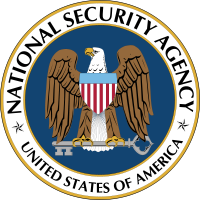Difference between revisions of "National Security Agency"
(→History: Filled in history section) |
|||
| Line 4: | Line 4: | ||
==History== | ==History== | ||
| + | The history of the agency can be traced back to July 1917 during the creation of the United States Cipher Bureau of Military Intelligence during WWI. The Bureau had been established for the purposes of code breaking following the British interception of the Zimmerman Telegram, which aimed to incite war between Mexico and the United States<ref>http://www.saturdayeveningpost.com/2014/04/17/culture/politics/a-brief-history-of-the-nsa.html</ref>. | ||
| + | |||
| + | In 1919, the Cipher Bureau relocated to New York City and shifted its objectives towards Diplomatic intelligence. In 1922, surveillance of Japanese telegrams helped American diplomats negotiate naval arms limitations in the Washington Naval Conference<ref>http://www.saturdayeveningpost.com/2014/04/17/culture/politics/a-brief-history-of-the-nsa.html</ref>. | ||
| + | |||
| + | During WWII, intelligence gathered by the bureau helped American fighter planes intercept and shoot down the plane of Japanese Admiral Yamamoto. | ||
| + | |||
| + | Following the conclusion of WWII, President Truman reorganized American signals intelligence into the National Security Agency in 1952. By 1969, the NSA grew to employ over 90,000 individuals making it world's largest intelligence organization. The agency played a key role in major Cold War events such as the Cuban Missile Crisis and the building of the Berlin Wall<ref>http://www.saturdayeveningpost.com/2014/04/17/culture/politics/a-brief-history-of-the-nsa.html</ref>. | ||
| + | |||
| + | In the 21st Century, the NSA's role shifted to data mining and domestic security following the September 11th attacks. President George W. Bush authorized the NSA to monitor the phone calls and emails of American citizens without the need for a court warrant<ref>http://www.saturdayeveningpost.com/2014/04/17/culture/politics/a-brief-history-of-the-nsa.html</ref>. | ||
| + | |||
| + | While the wiretap program was ended in 2007, later revelations made in 2013 by Edward Snowden revealed that the agency had be covertly gathering communications metadata from millions of Americans and foreign diplomats. | ||
==Careers== | ==Careers== | ||
Revision as of 02:49, 27 April 2016
The National Security Agency/Central Security Service (NSA/CSS) is a collaborative sector of the United States defense agencies, created in 1952. It presides over the creation and breaking of codes in accordance with the increasing necessity for cryptology in the armed forces and foreign affairs, as well as managing the communication and information systems of the United States. It provides services to the US Department of Defense, the Intelligence Community, government agencies, industry partners, select allies and coalition partners, and war planners and fighters. The NSA has two main missions: the Information Assurance mission prevents foreign adversaries from gaining access to sensitive, classified national security information; the Signals Intelligence mission "collects, processes, and disseminates intelligence information from foreign signals for intelligence and counterintelligence purposes and to support military operations." The NSA also is entrusted with the Network Warfare operations "to defeat terrorists and their organizations at home and abroad, consistent with U.S. laws and the protection of privacy and civil liberties." Keith B. Alexander is the Director of NSA and Chief of CSS. John C. Inglis is the Deputy Director of the NSA.[1][2]
History
The history of the agency can be traced back to July 1917 during the creation of the United States Cipher Bureau of Military Intelligence during WWI. The Bureau had been established for the purposes of code breaking following the British interception of the Zimmerman Telegram, which aimed to incite war between Mexico and the United States[3].
In 1919, the Cipher Bureau relocated to New York City and shifted its objectives towards Diplomatic intelligence. In 1922, surveillance of Japanese telegrams helped American diplomats negotiate naval arms limitations in the Washington Naval Conference[4].
During WWII, intelligence gathered by the bureau helped American fighter planes intercept and shoot down the plane of Japanese Admiral Yamamoto.
Following the conclusion of WWII, President Truman reorganized American signals intelligence into the National Security Agency in 1952. By 1969, the NSA grew to employ over 90,000 individuals making it world's largest intelligence organization. The agency played a key role in major Cold War events such as the Cuban Missile Crisis and the building of the Berlin Wall[5].
In the 21st Century, the NSA's role shifted to data mining and domestic security following the September 11th attacks. President George W. Bush authorized the NSA to monitor the phone calls and emails of American citizens without the need for a court warrant[6].
While the wiretap program was ended in 2007, later revelations made in 2013 by Edward Snowden revealed that the agency had be covertly gathering communications metadata from millions of Americans and foreign diplomats.
Careers
NSA in Popular Media
Ethical Concerns
Since 2001, the NSA has cooperated with the US government in illegal surveillance of domestic communications and communication records. It is known that major telecommunications carriers like AT&T also cooperate in handing over the requested documents and tapping customer telecommunications. The fact was first revealed in news in December 2005, then in May 2006, the USA Today wrote a story on the statements of several Congress members, who revealed that the NSA is also receiving copies of millions of civilian telecommunications records. All the activities are in violation of the privacy regulations established by Congress and the US Constitution.
AT&T is also fully involved with the organization, as it also installed a fiberoptic splitter at its facility at 611 Folsom Street in San Francisco, copying all emails, web browsing, and other forms of telecommunications to and from AT&T customers, providing the copies to the NSA.[7]
References
- ↑ http://www.nsa.gov/about/index.shtml
- ↑ http://www.nsa.gov/about/leadership/index.shtml
- ↑ http://www.saturdayeveningpost.com/2014/04/17/culture/politics/a-brief-history-of-the-nsa.html
- ↑ http://www.saturdayeveningpost.com/2014/04/17/culture/politics/a-brief-history-of-the-nsa.html
- ↑ http://www.saturdayeveningpost.com/2014/04/17/culture/politics/a-brief-history-of-the-nsa.html
- ↑ http://www.saturdayeveningpost.com/2014/04/17/culture/politics/a-brief-history-of-the-nsa.html
- ↑ https://www.eff.org/nsa-spying
